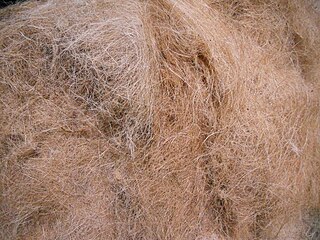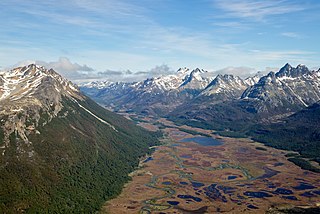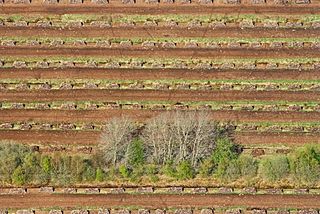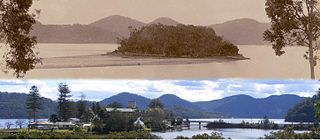
Lindow Man, also known as Lindow II and as Pete Marsh, is the preserved bog body of a man discovered in a peat bog at Lindow Moss near Wilmslow in Cheshire, North West England. The human remains were found on 1 August 1984 by commercial peat-cutters. Lindow Man is not the only bog body to have been found in the moss; Lindow Woman was discovered the year before, and other body parts have also been recovered. The find, described as "one of the most significant archaeological discoveries of the 1980s", caused a media sensation. It helped invigorate study of British bog bodies, which had previously been neglected in comparison to those found in the rest of Europe.

A bog or bogland is a wetland that accumulates peat, a deposit of dead plant material—often mosses, and in a majority of cases, sphagnum moss. It is one of the four main types of wetlands. Other names for bogs include mire, quagmire, and muskeg; alkaline mires are called fens. They are frequently covered in ericaceous shrubs rooted in the sphagnum moss and peat. The gradual accumulation of decayed plant material in a bog functions as a carbon sink.

Coir, or coconut fibre, is a natural fibre extracted from the husk of coconut and used in products such as floor mats, doormats, brushes and mattresses. Coir is the fibrous material found between the hard, internal shell and the outer coat of a coconut. Other uses of brown coir are in upholstery padding, sacking and horticulture. White coir, harvested from unripe coconuts, is used for making finer brushes, string, rope and fishing nets. It has the advantage of not sinking, so can be used in long lengths on deep water without the added weight dragging down boats and buoys.
In American sports, a three-peat is winning three consecutive championships. The term, a portmanteau of the words three and repeat, originated with the Los Angeles Lakers of the National Basketball Association, during their unsuccessful campaign for a third consecutive championship during the 1988–89 season, having won the previous 2 NBA Finals. The Lakers, however, were swept by the Detroit Pistons in the 1989 NBA Finals. The term is a registered trademark owned by Pat Riley, the Lakers' head coach from 1981–1990, although it was coined by L.A. player Byron Scott immediately after their successful championship defense against the Pistons in the 1988 NBA Finals.

Sphagnum is a genus of approximately 380 accepted species of mosses, commonly known as "peat moss". Accumulations of Sphagnum can store water, since both living and dead plants can hold large quantities of water inside their cells; plants may hold 16–26 times as much water as their dry weight, depending on the species. The empty cells help retain water in drier conditions. Hence, as sphagnum moss grows, it can slowly spread into drier conditions, forming larger mires, both raised bogs and blanket bogs. Thus, Sphagnum can influence the composition of such habitats, with some describing Sphagnum as 'habitat manipulators'. These peat accumulations then provide habitat for a wide array of peatland plants, including sedges and ericaceous shrubs, as well as orchids and carnivorous plants. Sphagnum and the peat formed from it do not decay readily because of the phenolic compounds embedded in the moss's cell walls. In addition, bogs, like all wetlands, develop anaerobic soil conditions, which produces slower anaerobic decay rather than aerobic microbial action. Peat moss can also acidify its surroundings by taking up cations, such as calcium and magnesium, and releasing hydrogen ions. Under the right conditions, peat can accumulate to a depth of many meters. Different species of Sphagnum have different tolerance limits for flooding and pH, so any one peatland may have a number of different Sphagnum species.
Bord na Móna, is a semi-state company in Ireland, created in 1946 by the Turf Development Act 1946. The company began developing the peatlands of Ireland with the aim to provide economic benefit for Irish Midland communities and achieve security of energy supply for the recently formed Irish Republic. The development of peatlands involved the mechanised harvesting of peat, which took place primarily in the Midlands of Ireland.

The Sweet Track is an ancient trackway, or causeway in the Somerset Levels, England, named after its finder, Ray Sweet. It was built in 3807 BC and is the second-oldest timber trackway discovered in the British Isles, dating to the Neolithic. It is now known that the Sweet Track was predominantly built over the course of an earlier structure, the Post Track.

Peat swamp forests are tropical moist forests where waterlogged soil prevents dead leaves and wood from fully decomposing. Over time, this creates a thick layer of acidic peat. Large areas of these forests are being logged at high rates.

Freshwater swamp forests, or flooded forests, are forests which are inundated with freshwater, either permanently or seasonally. They normally occur along the lower reaches of rivers and around freshwater lakes. Freshwater swamp forests are found in a range of climate zones, from boreal through temperate and subtropical to tropical.

Blanket bog or blanket mire, also known as featherbed bog, is an area of peatland, forming where there is a climate of high rainfall and a low level of evapotranspiration, allowing peat to develop not only in wet hollows but over large expanses of undulating ground. The blanketing of the ground with a variable depth of peat gives the habitat type its name. Blanket bogs are found extensively throughout the northern hemisphere - well-studied examples are found in Ireland and Britain, but vast areas of the Russian and North American tundra also qualify as blanket bogs.
Pete is a diminutive form of the given name Peter.
A hag is a wizened old woman, or a fairy with the appearance of an old woman.
Tropical peat is a type of histosol that found in tropical latitude, including South East Asia, Africa, and Central and South America. Tropical peat mostly consists of dead organic matter from trees instead of spaghnum which are commonly found in temperate peat. This soil usually contain high organic matter content, exceeding 75% with dry low bulk density around 0.2 mg/m3 (0.0 gr/cu ft).
Global warming in Russia describes the global warming related issues in Russia. This includes climate politics, contribution to global warming and the influence of global warming in Russia. In 2009 Russia was ready to reduce emissions 20–25% from its 1990 emission levels by the year 2020.

Raised bogs, also called ombrotrophic bogs, are acidic, wet habitats that are poor in mineral salts and are home to flora and fauna that can cope with such extreme conditions. Raised bogs, unlike fens are exclusively fed by precipitation (ombrotrophy) and from mineral salts introduced from the air. They thus represent a special type of bog, hydrologically, ecologically and in terms of their development history, in which the growth of peat mosses over centuries or millennia plays a decisive role. They also differ in character from blanket bogs which are much thinner and occur in wetter, cloudier climatic zones.
The acrotelm is one of two distinct layers in undisturbed peat bogs. It overlies the catotelm. The boundary between the two layers is defined by the transition from peat containing living plants (acrotelm) to peat containing dead plant material (catotelm). This typically coincides with the lowest level of the water table. Fluctuations in water table in a peat bog occur within the acrotelm, and hence conditions may vary from aerobic to anaerobic with time.

Andrus Jamerson Peat is an American football guard for the New Orleans Saints of the National Football League (NFL). He played college football at Stanford. As a high school senior, he was considered the best college football recruit by Sporting News. He committed to Stanford on February 1, 2012.

A mire is a wetland type, dominated by living, peat-forming plants. Mires arise because of incomplete decomposition of organic matter, due to waterlogging and subsequent anoxia. Like coral reefs, mires are unusual landforms in that they derive mostly from biological rather than physical processes, and can take on characteristic shapes and surface patterning.












